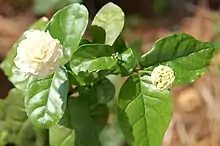| Jasmine | |
|---|---|
| Hex triplet | #F8DE7E |
| sRGBB (r, g, b) | (248, 222, 126) |
| HSV (h, s, v) | (47°, 49%, 97%) |
| CIELChuv (L, C, h) | (89, 68, 71°) |
| Source | ISCC-NBS |
| ISCC–NBS descriptor | Light yellow |
| B: Normalized to [0–255] (byte) | |

Example of jasmine: A double-flowered cultivar of Jasminum sambac in flower with an unopened bud. The flower smells like the tea as it opens.
The color jasmine is a pale tint of yellow, displayed at right.[1] It is a representation of the average color of the more yellowish lower part of the pale yellowish white colored jasmine flower. The first recorded use of jasmine as a color name in English was in 1925.[2]
In human culture
Politics
- The 2010–2011 Tunisian revolution, also called the Jasmine Revolution, was a color revolution. It started as a campaign of civil resistance in Tunisia that began in December 2010. It is widely regarded as having initiated the Arab Spring. The reason it was called the "jasmine revolution" was because the jasmine is the national flower of Tunisia.
See also
References
- ↑ http://tx4.us/nbs/nbs-j.htm Archived 2008-05-02 at the Wayback Machine ISCC-NBS Dictionary of Color Names (1955)--Color Sample of Jasmine (color sample #86)
- ↑ Maerz and Paul A Dictionary of Color New York:1930 McGraw-Hill Page 197; Color Sample of Jasmine: Page 41 Plate 9 Color Sample K4
External links
 The dictionary definition of jasmine at Wiktionary
The dictionary definition of jasmine at Wiktionary
This article is issued from Wikipedia. The text is licensed under Creative Commons - Attribution - Sharealike. Additional terms may apply for the media files.